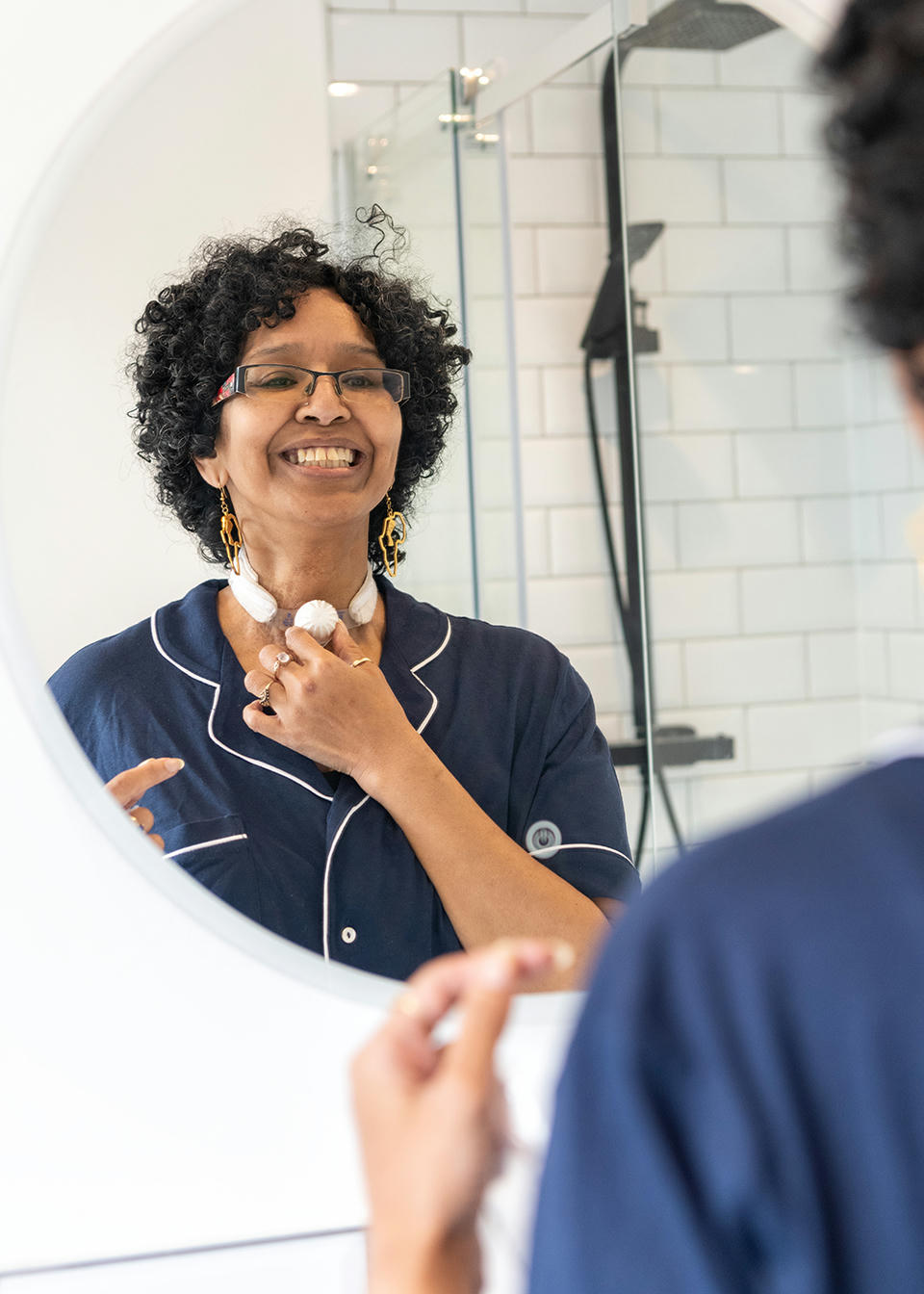Lung Health and Function of the Airway

After a tracheostomy, breathing undergoes significant changes as air enters directly through the tracheostomy tube, which requires new methods to ensure the air is properly filtered, warmed, and humidified. Understanding these changes to your breathing can help ensure your lungs stay healthy and your breathing remains comfortable after a tracheostomy.
Breathing Before and After a Tracheostomy
Your lungs are responsible for providing oxygen to your bloodstream and removing carbon dioxide from the body. For your lungs to function well, the air you breathe needs to be conditioned, meaning the air is naturally warmed, filtered, and humidified by the upper airway which includes your nose, mouth, and throat.


After a tracheotomy, breathing occurs through the tracheostoma via the tube in your neck, which means air will not pass through the upper airway, therefore entering as unconditioned air. Breathing unconditioned air that is cold, dry, and unfiltered may lead to thicker mucus, more coughing, and higher risk of infections.
Cilia Cells and Mucus Layers
Before a tracheotomy, your airway naturally defends against germs. Mucus layers trap particles like viruses and bacteria and keep the airway moist, while cilia move particles out of your respiratory tract. This process happens in three key layers lining your airways.
These layers need a warm, humid environment to work effectively and preserve their relationship. Any changes can impact their function and ability to protect you.
Different Ways to Condition the Air After a Tracheotomy
Since the air no longer passes through the nose and mouth, new methods are necessary to condition the air you breathe in. There are several ways to humidify the air which can be used alone or in combination. External humidifiers provide cold or warm water vapor supplied via a mask near your tracheostomy tube and usually need electricity for heat. Nebulizers deliver saline or medication mist to the lungs. Staying hydrated by taking enough fluids daily is also important to keep mucus thin and easier to clear.
A better way to breathe
A Heat and Moisture Exchanger or HME is a device that conditions the air you breathe in a similar way to your nose. An HME attaches to the end of your tracheostomy tube, allowing you to breathe in and out through it. When breathing out through the HME, heat and moisture from the lower airway is captured or stored within the HME.
Upon breathing in again, this heat and moisture is released from the HME and returned to the airways.
HMEs condition the air by keeping it at a good humidity and temperature for the lungs to function properly, compensating for no longer breathing through your nose and mouth. Improvements in lung health and quality of life have been observed in patients wearing an HME as they may help to produce less mucus, cough less, and feel less irritation in the airway.


Different Types of HMEs
TrachPhone
TrachPhone is a versatile HME suitable for wearing in different situations. This lightweight device includes a finger-pressed valve for speech, reopening automatically upon release. It can be worn day and night. TrachPhone also supports suctioning and supplemental oxygen use.

Freevent XtraCare
Freevent XtraCare is an HME with a filter, providing both good humidification and extra protection. XtraCare can be used when extra protection is needed, such as during flu season, in crowded areas, or for hospital visits. It also helps protect against fine airborne particles like pollen.
- Filtration of bacteria: > 99%*
- Filtration of viruses: > 99%*
XtraCare also filters the air you breathe out through your tracheostoma, offering protection to others around you.
**Please note: Since pathogens can enter and leave the human body in other ways, (such as the mouth, nose, and eyes), Freevent XtraCare can never guarantee complete protection. Please read the instructions for use for guidance.

Freevent DualCare
Freevent DualCare combines a one-way speaking valve with an HME enabling hands-free speech and supporting your lungs with heat and moisture. Switching between modes is done by twisting the lid of the speaking valve.
Consult your clinician to choose the right HME and read the instructions before using any products.

Benefits of Wearing an HME
Before surgery, your upper airway conditions the air you breathe. After a tracheotomy, HMEs can help do this for you. An HME attaches to the front of your tracheostomy tube, and you breathe through it. Read below the potential benefits of wearing an HME:
- Cough reduction
- Less irritation in the airway
- Reduction in mucus
- Improvements in lung health
- Protection from viruses and bacteria*
* When using an HME with an electrostatic filter, that helps to reduce the inhalation of viruses and bacteria, e.g. Freevent XtraCare.

Learn more:
Getting started with an HME
The importance of wearing an HME to take care of your pulmonary health after a tracheostomy procedure and a clear guidance how to start using it
Learn more
Skin Health
Maintaining the health of your stoma and the surrounding skin after a tracheostomy is an essential part of care. This guide provides you with information to ensure proper care and management of your skin and stoma.
Learn more
Tracheostomy tubes
Learning the parts of your tracheostomy tube and their purpose can help you or your caregiver manage it more effectively.
Learn more
Eating and drinking
Valuable information about the impact of tracheostomy on eating and drinking functions and some useful tips
Learn more
Speaking with a tracheostomy
The loss of speech following a tracheostomy can be both challenging and isolating. However Recovery of vocal function is still possible.
Learn more
References
- de Kleijn BJ, van As-Brooks CJ, Wedman J, van der Laan BFAM. Clinical feasibility study of protrach dualcare a new speaking valve with heat and moisture exchanger for tracheotomized patients. Laryngoscope Investigative Otolaryngology. 2017;2(6):453-8.
- Mercke U, Toremalm NG. Air humidity and mucociliary activity. Ann Otol Rhinol Laryngol. 1976 Jan-Feb;85(1 Pt 1):32-7.
- Nelson Laboratories, Bacterial Filtration Efficiency (BFE) GLP Report, Salt Lake City, USA. Available on request from Atos Medical. www.atosmedical.com. 2014.
- Nelson Laboratories, Viral Filtration Efficiency (VFE) GLP Report, Salt Lake City, USA. Available on request from Atos Medical. www.atosmedical.com. 2014.
- Parrilla C, Minni A, Bogaardt H, Macri GF, Battista M, Roukos R, Pandolfini M, Ruoppolo G, Paludetti G, D’Alatri L, de Vincentiis M. Pulmonary Rehabilitation After Total Laryngectomy: A Multicenter Time-Series Clinical Trial Evaluating the Provox XtraHME in HME-Naïve Patients. Ann Otol Rhinol Laryngol. 2015 Sep;124(9):706-13.
- Thomachot L, Viviand X, Arnaud S, Vialet R, Albanese J, Martin C. Preservation of humidity and heat of respiratory gases in spontaneously breathing, tracheostomized patients. Acta Anaesthesiol Scand. 1998 Aug;42(7):841-4.
- Vitacca M, Clini E, Foglio K, Scalvini S, Marangoni S, Quadri A, et al. Hygroscopic condenser humidifiers in chronically tracheostomized patients who breathe spontaneously. Eur Respir J. 1994;7(11):2026-32.
- Williams R, Rankin N, Smith T, Galler D, Seakins P. Relationship between the humidity and temperature of inspired gas and the function of the airway mucosa. Crit Care Med. 1996;24(11):1920-9.
- Zuur JK, Muller SH, de Jongh FH, Van ZN, Hilgers FJ. The physiological rationale of heat and moisture exchangers in post-laryngectomy pulmonary rehabilitation: a review. Eur Arch Otorhinolaryngol. 2006;263(1):1-8.
PM36934_202502




